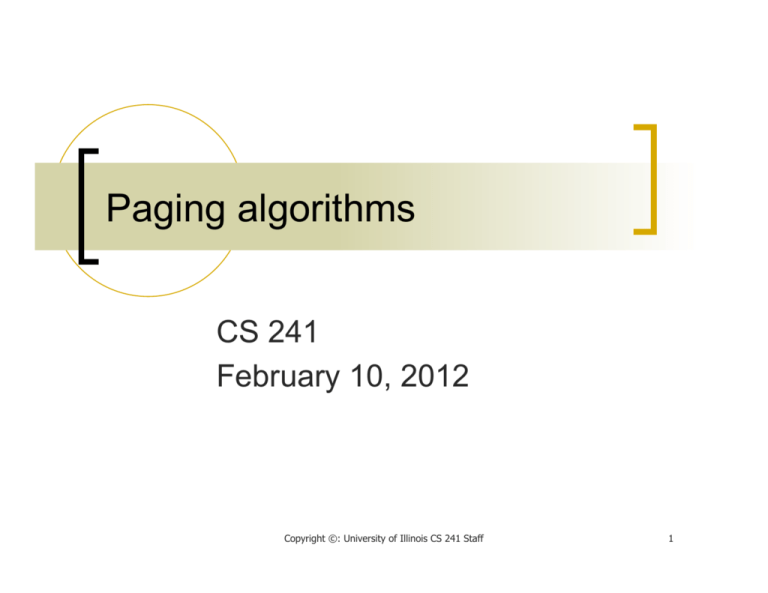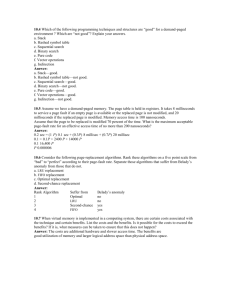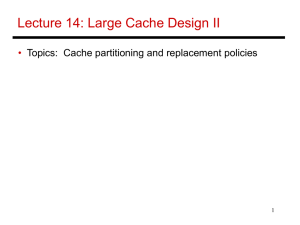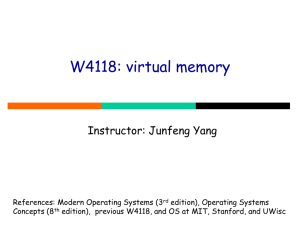Paging algorithms
advertisement

Paging algorithms CS 241 February 10, 2012 Copyright ©: University of Illinois CS 241 Staff 1 Announcements MP2 due Tuesday Fabulous Prizes Wednesday! 2 Paging On heavily-loaded systems, memory can fill up Need to make room for newly-accessed pages Heuristic: try to move “inactive” pages out to disk What constitutes an “inactive” page? Paging Refers to moving individual pages out to disk, and back We often use the terms “paging” and “swapping” interchangeably Different from context switching Background processes often have their pages remain resident in memory Paging could occur even with only one process running 3 Basic Page Replacement Find the location of the desired page on disk Find a free frame If there is a free frame, use it If there is no free frame, use a page replacement algorithm to select a victim frame Read the desired page into the (newly) free frame. Update the page and frame tables. Note: can also evict in advance OS keeps pool of “free pages” around, even when memory is tight Makes allocating a new page fast The process of evicting pages to disk is then performed 4 in the background Exploiting Locality Exploiting locality Locality helps to reduce the frequency of paging Temporal locality: Memory accessed recently tends to be accessed again soon Spatial locality: Memory locations near recently-accessed memory is likely to be referenced soon Once something is in memory, it should be used many times This depends on many things: The amount of locality and reference patterns in a program The page replacement algorithm The amount of physical memory and the application footprint 5 Fundamental technique: caching A cache keeps a subset of a data set in a more accessible but space-limited location Caches are everywhere in systems Such as…? 6 Fundamental technique: caching A cache keeps a subset of a data set in a more accessible but space-limited location Caches are everywhere in systems Registers are a cache for L1 cache which is a cache for L2 cache which is a cache for memory which is a cache for disk which might be a cache for a remote file server Web proxy servers make downloads faster & cheaper Web browser stores downloaded files Local DNS servers remember recently-resolved DNS names Google servers remember your searches Key goal: minimize cache miss rate = minimize page fault rate (in context of paging) Requires a good algorithm 7 Evicting the Best Page Goal of the page replacement algorithm: The “best” pages are those that will never be used again Reduce page fault rate by selecting the best page to evict However, it's impossible to know in general whether a page will be touched If you have information on future access patterns, it is possible to prove that evicting those pages that will be used the furthest in the future will minimize the page fault rate What is the best algorithm for deciding the order to evict pages? Much attention has been paid to this problem. Used to be a very hot research topic. These days, widely considered solved (at least, solved well enough) 8 Algorithm: OPT (a.k.a. MIN) Evict page that won't be used for the longest time in the future Of course, this requires that we can foresee the future... So OPT cannot be implemented! This algorithm has the provably optimal performance Hence the name “OPT” OPT is useful as a “yardstick” to compare the performance of other (implementable) algorithms against 9 The Optimal Page Replacement Algorithm Idea: Select the page that will not be needed for the longest time in the future Time Requests 0 1 c 2 a 3 d 4 b Page 0 Frames 1 2 3 a b c d a b c d a b c d a b c d a b c d Page faults 5 e 6 b 7 a 8 b 9 c 10 d X Copyright ©: University of Illinois CS 241 Staff 10 The Optimal Page Replacement Algorithm Idea: Select the page that will not be needed for the longest time in the future Time Requests 0 1 c 2 a 3 d 4 b 5 e 6 b 7 a 8 b 9 c Page 0 Frames 1 2 3 a b c d a b c d a b c d a b c d a b c d a b c e a b c e a b c e a b c e a b c e Page faults X Copyright ©: University of Illinois CS 241 Staff 10 d X 11 The Optimal Page Replacement Algorithm Idea: Select the page that will not be needed for the longest time in the future Time Requests 0 1 c 2 a 3 d 4 b 5 e 6 b 7 a 8 b 9 c 10 d Page 0 Frames 1 2 3 a b c d a b c d a b c d a b c d a b c d a b c e a b c e a b c e a b c e a b c e a b c d Page faults X Copyright ©: University of Illinois CS 241 Staff X 12 Algorithms: Random and FIFO Random: Throw out a random page FIFO: Throw out pages in the order that they were allocated Obviously not the best scheme Although very easy to implement! Maintain a list of allocated pages When the length of the list grows to cover all of physical memory, pop first page off list and allocate it Why might FIFO be good? Why might FIFO not be so good? 13 Algorithms: Random and FIFO FIFO: Throw out pages in the order that they were allocated Why might FIFO be good? Maintain a list of allocated pages When the length of the list grows to cover all of physical memory, pop first page off list and allocate it Maybe the page allocated very long ago isn’t used anymore Why might FIFO not be so good? Doesn’t consider locality of reference! Suffers from Belady’s anomaly: Performance of an application might get worse as the size of physical memory increases!!! 14 Belady’s Anomaly time Access pattern Physical memory (3 page frames) 0 1 2 3 0 1 4 0 1 2 3 4 0 0 0 1 2 3 0 0 0 1 4 4 1 1 2 3 0 1 1 1 4 2 2 2 3 0 1 4 4 4 2 3 3 9 page faults! time Access pattern Physical memory (4 page frames) 0 1 2 3 0 1 4 0 1 2 3 4 0 0 0 0 0 0 1 2 3 4 0 1 1 1 1 1 1 2 3 4 0 1 2 2 2 3 2 2 3 3 3 4 4 0 1 0 1 2 2 3 3 4 10 page faults! 15 Algorithm: Least Recently Used (LRU) Evict the page that was used the longest time ago Keep track of when pages are referenced to make a better decision Use past behavior to predict future behavior When does LRU work well, and when does it not? Implementation LRU uses past information, while OPT uses future information Every time a page is accessed, record a timestamp of the access time When choosing a page to evict, scan over all pages and throw out page with oldest timestamp Problems with this implementation? 16 Algorithm: Least Recently Used (LRU) Evict the page that was used the longest time ago Keep track of when pages are referenced to make a better decision Use past behavior to predict future behavior When does LRU work well, and when does it not? Implementation LRU uses past information, while OPT uses future information Every time a page is accessed, record a timestamp of the access time When choosing a page to evict, scan over all pages and throw out page with oldest timestamp Problems with this implementation? 32-bit timestamp would double size of PTE Scanning all of the PTEs for lowest timestamp: slow 17 Least Recently Used (LRU) Keep track of when a page is used Replace the page that has been used least recently Time Requests 0 Page 0 Frames 1 2 3 a b c d 1 c 2 a 3 d 4 b 5 e 6 b 7 a 8 b 9 c 10 d Page faults Copyright ©: University of Illinois CS 241 Staff 18 Least Recently Used (LRU) Keep track of when a page is used Replace the page that has been used least recently (farthest in the past) Time Requests 0 1 c 2 a 3 d 4 b Page 0 Frames 1 2 3 a b c d a b c d a b c d a b c d a b c d Page faults 5 e 6 b 7 a 8 b 9 c 10 d X Copyright ©: University of Illinois CS 241 Staff 19 Least Recently Used (LRU) Keep track of when a page is used Replace the page that has been used least recently (farthest in the past) Time Requests 0 1 c 2 a 3 d 4 b 5 e 6 b 7 a 8 b Page 0 Frames 1 2 3 a b c d a b c d a b c d a b c d a b c d a b e d a b e d a b e d a b e d Page faults X Copyright ©: University of Illinois CS 241 Staff 9 c 10 d X 20 Least Recently Used (LRU) Keep track of when a page is used Replace the page that has been used least recently (farthest in the past) Time Requests 0 1 c 2 a 3 d 4 b 5 e 6 b 7 a 8 b 9 c Page 0 Frames 1 2 3 a b c d a b c d a b c d a b c d a b c d a b e d a b e d a b e d a b e d a b e c Page faults X Copyright ©: University of Illinois CS 241 Staff X 10 d X 21 Least Recently Used (LRU) Keep track of when a page is used Replace the page that has been used least recently (farthest in the past) Time Requests 0 1 c 2 a 3 d 4 b 5 e 6 b 7 a 8 b 9 c 10 d Page 0 Frames 1 2 3 a b c d a b c d a b c d a b c d a b c d a b e d a b e d a b e d a b e d a b e c a b d c X X Page faults X Copyright ©: University of Illinois CS 241 Staff 22 Least Recently Used 3 frames of physical memory Run this for a long time with LRU page replacement: while true! for (i = 0; i < 4; i++)! read from page i! Q1: What fraction of page accesses are faults? None or almost none About 1 in 4 About 2 in 4 About 3 in 4 All or almost all Q2: How well does OPT do? 23 24 Least Recently Used 3 frames of physical memory Run this for a long time with LRU page replacement: while true! for (i = 0; i < 4; i++)! read from page i! Q1: What fraction of page accesses are faults? None or almost none About 1 in 4 About 2 in 4 About 3 in 4 All or almost all – least recently used is always next to be used! Q2: How well does OPT do? 25 Least Recently Used Issues Not optimal Does not suffer from Belady's anomaly Implementation Use time of last reference Use a stack Update every time page accessed (use system clock) Page replacement - search for smallest time On page access : remove from stack, push on top Victim selection: select page at bottom of stack Both approaches require large processing overhead, more space, and hardware support. Copyright ©: University of Illinois CS 241 Staff 26 Approximating LRU Use the PTE reference bit and a small counter per page Periodically (say every 100 msec), scan all physical pages in the system. For each page: (Use a counter of, say, 2 or 3 bits in size, and store it in the PTE) If not accessed recently, (PTE reference bit == 0), counter++! If accessed recently (PTE reference bit == 1), counter = 0! Clear the PTE reference bit in either case! Counter will contain the number of scans since the last reference to this page. PTE that contains the highest counter value is the least recently used So, evict the page with the highest counter 27 Approximate LRU Example time 0 0 0 0 0 0 0 0 0 0 0 0 0 0 0 0 1 1 1 0 0 1 1 0 1 0 1 1 0 0 0 1 1 1 0 0 1 1 0 1 0 1 1 0 0 0 2 0 0 0 1 2 2 0 0 1 0 2 1 0 Accessed pages in blue Increment counter for untouched pages These pages have the highest counter value and can be evicted. 28 Algorithm: LRU Second-Chance (Clock) LRU requires searching for the page with the highest lastref count Can do this with a sorted list or a second pass to look for the highest value Simpler technique: Second-chance algorithm “Clock hand” scans over all physical pages in the system Clock hand loops around to beginning of memory when it gets to end If PTE reference bit == 1, clear bit and advance hand to give it a second-chance If PTE reference bit == 0, evict this page No need for a counter in the PTE! Accessed pages in blue Clock hand Evict! 29 Algorithm: LRU Second-Chance (Clock) This is a lot like LRU, but operates in an iterative fashion To find a page to evict, just start scanning from current clock hand position What happens if all pages have ref bits set to 1? What is the minimum “age” of a page that has the ref bit set to 0? Slight variant -- “nth chance clock” Only evict page if hand has swept by N times Increment per-page counter each time hand passes and ref bit is 0 Evict a page if counter ≥ N Counter cleared to 0 each time page is used 30 Swap Files What happens to the page that we choose to evict? Depends on what kind of page it is and what state it's in! OS maintains one or more swap files or partitions on disk Special data format for storing pages that have been swapped out 31 Swap Files How do we keep track of where things are on disk? Recall PTE format When V bit is 0, can recycle the PFN field to remember something about the page. V bit 5 bits 0 Swap file index 24 bits Swap file offset Swap file (max 224 pages = 64 GB) Swap file table (max 32 entries) But ... not all pages are swapped in from swap files! E.g., what about executables? 32 Page Eviction How we evict a page depends on its type. Code page: Just remove it from memory – can recover it from the executable file on disk! Unmodified (clean) data page: If the page has previously been swapped to disk, just remove it from memory Assuming that page's backing store on disk has not been overwritten If the page has never been swapped to disk, allocate new swap space and write the page to it Exception: unmodified zero page – no need to write out to swap at all! Modified (dirty) data page: If the page has previously been swapped to disk, write page out to the swap space If the page has never been swapped to disk, allocate new swap 33 space and write the page to it Physical Frame Allocation How do we allocate physical memory across multiple processes? Local replacement algorithms Per-process limit on the physical memory usage of each process When a process reaches its limit, it evicts pages from itself Global-replacement algorithms What if Process A needs to evict a page from Process B? How do we ensure fairness? How do we avoid having one process hogging the entire memory of the system? Physical size of processes can grow and shrink over time Allow processes to evict pages from other processes Note that one process' paging can impact performance of entire system! One process that does a lot of paging will induce more disk I/O 34 Working Set A process's working set is the set of pages that it currently “needs” Definition: WS(P, t, w) = the set of pages that process P accessed in the time interval [t-w, t] “w” is usually counted in terms of number of page references Working set changes over the lifetime of the process A page is in WS if it was referenced in the last w page references Periods of high locality exhibit smaller working set Periods of low locality exhibit larger working set Basic idea: Give process enough memory for its working set If WS is larger than physical memory allocated to process, it will tend to swap If WS is smaller than memory allocated to process, it's wasteful This amount of memory grows and shrinks over time 35 Estimating the Working Set How do we determine the working set? Simple approach: modified clock algorithm Sweep the clock hand at fixed time intervals Record how many seconds since last page reference All pages referenced in last T seconds are in the working set Now that we know the working set, how do we allocate memory? If working sets for all processes fit in physical memory, done! Otherwise, reduce memory allocation of larger processes Idea: Big processes will swap anyway, so let the small jobs run unencumbered Very similar to shortest-job-first scheduling: give smaller processes better chance of fitting in memory How do we decide the working set time limit T? If T is too large, very few processes will fit in memory If T is too small, system will spend more time swapping Which is better? 36 Page Fault Frequency Dynamically tune memory size of process based on # page faults Monitor page fault rate for each process (faults per sec) If page fault rate above threshold, give process more memory Should cause process to fault less Doesn't always work! Recall Belady's Anomaly If page fault rate below threshold, reduce memory allocation What happens when everyone’s page fault rate is high? 37 Thrashing As system becomes more loaded, spends more of its time paging Eventually, no useful work gets done! CPU utilization Thrashing Number of processes System is overcommitted! If the system has too little memory, the page replacement algorithm doesn't matter Solutions? Change scheduling priorities to “slow down” processes that are thrashing Identify process that are hogging the system and kill them? Is thrashing a problem on systems with only one user? 38







